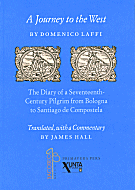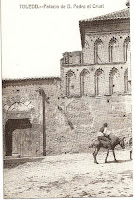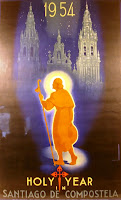
A friend who walked his 4th camino in September told me, “I don’t think I’ll walk that route
[the Camino
[the Camino
This set me thinking. 'What did it used to be like? It was a forgotten relic for almost 400 years and was only revived in the early 1980's, so what was it like before it died off?
What was the Camino Frances like in the middle ages?
Wasn’t it overcrowded and commercialised then too?
There are legends and urban legends about the numbers of pilgrims to Santiago de Compostela in the middle ages. Many are grossly exaggerated; some claim that over 500 000 pilgrims walked to
Documented numbers of pilgrims, and of hospices built to house them, provide some evidence of the popularity Santiago
How many pilgrims were there?
“.. in 1121, when Ali-ben-Yussef, the Almorávide, sent a deputation to Doña Urraca, the legates were amazed at the crowds of pilgrims who thronged the roads. They enquired from their escort in whose honor so great a multitude of Christians crossed the Pyrenees . “He who deserves such reverence,” answered the escort, “is St. James…” (Walter Starkie)
Research for the book “Jacobean Pilgrims from England to St. James of Compostella” by Constance Storrs showed that the majority of Jacobean pilgrims from England went to Spain
“From 1390 to 1399 pilgrims went every year in ships of West Country, south-or-south-east ports, the greatest number in 1395, a Jubilee Year. In the 15th-c the most favoured were the Holy Years of which three in particular, 1428, 1434 and 1445 had the heaviest traffic although in 1451, 1456 and 1484 pilgrims going by sea were still numerous … and, if the licence holders of these years did in fact carry full numbers .. some thousands of English pilgrims visited the apostle’s shrine in the 15th-c.” ²
16th-c
A register dating1594 at the hospice at Villafranca de Montes de Oca recorded 16,767 pilgrims that year, over 200 on some days.
17th-c
 “As late as the 17th-c, well into the decline of the pilgrimage, the
“As late as the 17th-c, well into the decline of the pilgrimage, the
(Canons of Roncesvalles - a monastery established to care for pilgrims in the 12th-c)
Growth from the 10th to 17th-c:
 As the number of pilgrims to Compostela increased, more and more refuges were established. In the 9th-c the majority were simple shelters attached to parish churches and provided floor space for small numbers of pilgrims. Royalty and wealthy families sponsored the building of many hospices, even in remote areas. At least four were established in Villafranca de Montes de Oca. Alfonso III built the Hospital de la Reina in 884. In 1270 Doná Vilonate founded another and Enrique’s queen, Juana Manuel, built another in 1380. It was improved and enlarged in the 15th-c. Pilgrims brought prosperity and entire villages, such as Estella, were established as a result of the pilgrimage. Shops, markets, manufacturers, artisans, inns, taverns and all sorts of traders benefited from the rise in pilgrim numbers.
As the number of pilgrims to Compostela increased, more and more refuges were established. In the 9th-c the majority were simple shelters attached to parish churches and provided floor space for small numbers of pilgrims. Royalty and wealthy families sponsored the building of many hospices, even in remote areas. At least four were established in Villafranca de Montes de Oca. Alfonso III built the Hospital de la Reina in 884. In 1270 Doná Vilonate founded another and Enrique’s queen, Juana Manuel, built another in 1380. It was improved and enlarged in the 15th-c. Pilgrims brought prosperity and entire villages, such as Estella, were established as a result of the pilgrimage. Shops, markets, manufacturers, artisans, inns, taverns and all sorts of traders benefited from the rise in pilgrim numbers.
Hospices - pilgrim shelters
 In the middle ages almost every town and village on the Camino Frances supported at least one pilgrim hospice. Many were small - a favourite number was 12 beds that corresponded with the numbers of apostles.
In the middle ages almost every town and village on the Camino Frances supported at least one pilgrim hospice. Many were small - a favourite number was 12 beds that corresponded with the numbers of apostles.The town with the highest number was
Astorga had 21, Carrion de los Condes had 14 and at one time there were 7 in Castrojeriz. Even small villages like Obanos and Viana had several pilgrim shelters. Terradillos de los Templarios and neighbouring Moratinos were among the few pueblos that did not provide a hospice for pilgrims.
Just as they are today, some hospices were provided by Confraternities, some by the church and some were privately run.
How many hospices were there?
It is not possible to know how many hospices existed at any one time on the Camino Frances. Numbers fluctuated between the 10th and 15th centuries. By adding up all the hospices actually mentioned in the books The Road to Santiago by Gitlitz and Davidson and The Pilgrim’s Guide to Santiago de Compostela by Annie Shaver-Crandell and Paula Gerson, we know that by the 15th-c there were at least 161. One would have to make a few assumptions regarding the others. Gitlitz and Davidson say that in some villages there were, “… several pilgrim hospices” and that others had, “…. many pilgrim hospices.”
Towns that had ‘several’ or ‘many’ include Pamplona (at least 6), Obanos, Estella (about 11), Logrono , Najera, Sahagun (4 in the late 15th-c), Puente de Villarente , Leon (many), Portomarin and Santiago
One can reasonably estimate that in the middle ages, at the height of the popularity of the pilgrimage to Santiago
(As of June 2008 there are about 130 albergues (Red de Albergues 2008 Brochure.)
The decline of the pilgrimage
In 1589 the relics of the saint were moved and hidden from a possible attack by Frances Drake – and were then forgotten for almost 300 years! It’s not surprising that the number of pilgrims to
An occasional foreign pilgrim still walked to Compostela and some wrote about their journeys. Domenico Laffi, an Italian priest walked from his hometown in Bologna  lian, Nicola Albani, walked from
lian, Nicola Albani, walked from Genoa
 lian, Nicola Albani, walked from
lian, Nicola Albani, walked from
“In the 17th century, the Spanish national cult of Santiago experienced a crisis when it was challenged by that of saint Teresa of Avila , a hugely popular 16th century mystic St. James remained the patron of Spain, but the quarrel left the cult much weakened. In late 17th century, the pilgrimage experienced something of a revival and reached a new (if more modest, honestly religious) peak, but mid-18th century again saw a marked decline. The scientific and industrial revolution in 19th century also rendered the pilgrimage obsolete in the rest of Europe .” Antti Lahelma
19th-c
The Spanish Civil war of 1820 – 1823 further prevented pilgrims from visitingSantiago
The Spanish Civil war of 1820 – 1823 further prevented pilgrims from visiting
“In the Holy Year of 1867 just 40 pilgrims turned up for the celebrated mass on 25th July.” ³
A sear ch for the relics was launched in 1879 and they were eventually found between the walls of the apse. “A papal bull from Pope Leo XIII (in 1884) declared them to be genuine in order to silence sceptics.” ³
ch for the relics was launched in 1879 and they were eventually found between the walls of the apse. “A papal bull from Pope Leo XIII (in 1884) declared them to be genuine in order to silence sceptics.” ³
 ch for the relics was launched in 1879 and they were eventually found between the walls of the apse. “A papal bull from Pope Leo XIII (in 1884) declared them to be genuine in order to silence sceptics.” ³
ch for the relics was launched in 1879 and they were eventually found between the walls of the apse. “A papal bull from Pope Leo XIII (in 1884) declared them to be genuine in order to silence sceptics.” ³
A New York Times article describes the 15th August 1965 Holy Year celebration.
“.. hundreds of pilgrims including scores of priests in black cassocks lining up in the Obradoiro square.. The worshippers who stream into Santiago by bus and car … The 50 miles of road from La Coruna
It was mainly art historians who showed interest in the old pilgrimage  roads to Compostela. Georgiana Goddard
roads to Compostela. Georgiana Goddard  King published her book, “The Way of St James”, in 1920. This book in turn inspired Walter Starkie to make 4 pilgrimages to
King published her book, “The Way of St James”, in 1920. This book in turn inspired Walter Starkie to make 4 pilgrimages to Santiago
 roads to Compostela. Georgiana Goddard
roads to Compostela. Georgiana Goddard  King published her book, “The Way of St James”, in 1920. This book in turn inspired Walter Starkie to make 4 pilgrimages to
King published her book, “The Way of St James”, in 1920. This book in turn inspired Walter Starkie to make 4 pilgrimages to
In 1937 Sant’Iago was officially restored as the patron saint of Spain
The modern pilgrimage - 20th-c
The modern pilgrimage, as we know it, really only started in the 1970’s although a motorised pilgrimage was promoted in the Holy Years starting in 1954, complete with a credencial and a diploma at the end.
David Gitlitz’s imagination was fired by Walter Starkie’s accounts of his pilgrimage experiences. When Linda and David walked the old pilgrimage paths across
The numbers of pilgrims who have received the Compostela increased from about 6 in 1972 to 114 000 in 2007. This was the highest number of pilgrims, outside the Holy Years, since the reanimation of the pilgrimage in the early 1980’s.
(This number does not include the many thousands who walk short sections of the various camino roads during their holidays and do not receive the Compostela certificate.)
The reanimation of the route from Roncesvalles to Santiago can be attributed to D Elias Valeno Sampedro, the parish priest of O Cebreiro who devoted his life to rediscovering the old ways.
" In the 1970’s there survived only a remote memory of the Jacobean pilgrimage” he wrote. In 1971 he wrote the book ‘Caminos a Compostela’."
Don Elias’ guide was published in 1982 and at a gathering in Santiago
Back to the Past
The roads to Santiago
Another important feature that helped to keep the phenomenon of Jacobean pilgrimage alive was hospitality, which on the Way of Saint James involved both rich and poor. The practice of hospitality led to the founding of welfare institutions that attended to the spiritual, material and health needs of the pilgrims. According to their ecclesiastical, civil or popular origins, the centres can be classified as episcopal or cathedral hospitals, hospitals run by the military, monastic or royal orders, noble foundations, parish hospitals, and in the cities along the Way, hospitals run by guilds and religious brotherhoods. Especially important in this respect were the monasteries of Cluny and the military orders, especially the Knights Hospitaller. (Xacobeo.es)
Competition in commerce and industry flourished and there was a vibrant tourist industry.
“In medieval times the Compostela tourist industry pitched its wares in Lavaolla. Documents tell us that just like today’s merchants, 12th-c Compostelans posted advertisements, in a variety of languages, touting the virtues and prices of their inns, restaurants and taverns.” ¹
The Galician Xunta expects to host over 10 million visitors to Santiago
Perhaps el Camino is becoming exactly as it used to be in the middle ages!!
1. The Road to Santiago
2. Jacobean Pilgrims from England
3: Camino de Santiago - Cordla Rabe, Rother Walking Guide.
4. The Pilgrim’s Guide to Santiago de Compostela” - Annie Shaver-Crandell and Paula
Gerson






Hypothetical assumptions: 200 refugios, say each one can serve 400 pilgrims. Half of these pilgrims are returning home, so each day 200 go towards Santiago, and eventually those 200 per day reach Santiago. Over 12 months, 360 x 200 = 72000 pilgrims arrive in Santiago. If their average stay is a month, 6000 are wandering around the city. These numbers are extremely low, so maybe staying in a refugio was the exception, like staying in a hospital for us? If you assume that only 10% of pilgrims were ill or tired enough to need a refugio, then you get 720000 per year arriving in Santiago, and 60000 there at any one time. Seems a little more plausible.
ReplyDeleteQuote:
ReplyDelete.... then you get 720000 per year arriving in Santiago..."
Do you mean 72000? 720 000 seems a bit much?
Sil
If you assume half of a 400 person refugio is going towards Santiago, and all the pilgrims go thru that refugio, then your arrival rate at Santiago is 200 per day, or about 72000 (200 times 360) per year. That's too low, so the question is what percent of the pilgrims stay in a refugio. If you assume that the 200 Santiago bound pilgrims that stay in the refugio represent only 10% of the total, then the total is 720,000, which does seem high. But, if we know the average size of the refugios, and have some number for the percent of the total that represents, then we can estimate the total. My biggest assumption is that half of the refugio population is composed of pilgrims going home. If that is true, and we assume that only the ill stay in the refugio, then maybe 10% of the total do stay in refugios, and if so 720,000 is a reasonable estimate. My other assumption is that the number of pilgrims is the same all year. If 100% are in 9 months, then the annual total is 200 times 360 times 9/12, or about 500,000 per year.
ReplyDeleteYou can tell that in my paid life, I worked with numbers.
Reading some of the 2001 CSJ Conference papers (Hospitality through the ages on the Roads to Compostela) it seems that most 'hospices' were initially small, catering for only a few pilgrims. Churches allowed pilgrims to bed down in the cloisters and aisles of the church. I doubt that many could have cater for 400 pilgrims. This is, however, all conjecture. Don Jose Ignacio Diaz Perez (then co-coordinator of the hospitaleros) is of the opinion that was never a network of refuges as there is today.
ReplyDeleteVery interesting post, Sil! When I lived in Spain in 1973-74, I never even heard of the Camino. Of course, at that time, Franco was still alive and the North of Spain seemed very remote from the rest of the country. But it is fascinating how even in the long history of the Camino, 40 years can make such a profound difference. Gracias a Don Elias!
ReplyDelete